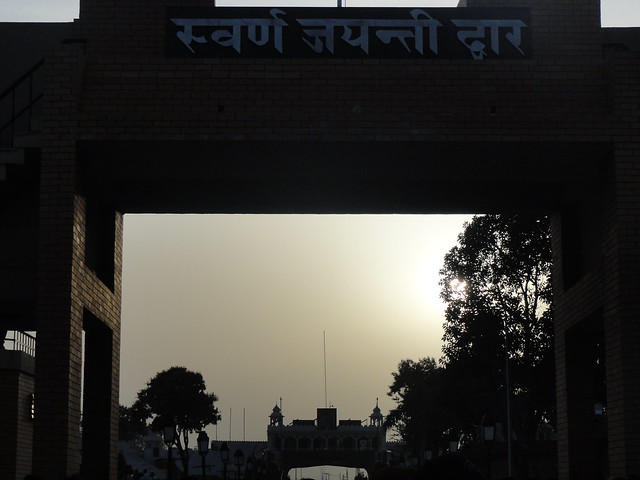After Jallianwala Bagh and Durgiana Temple, it was time to go to the Indo-Pak border. The Wagah border crossing is the only such crossing between India and Pakistan. The journey of about 30 km from the city of Amritsar to Wagah border took around one hour. The road to Wagah was surrounded by lush green wheat fields, typical of roads in outskirts of cities in Indo-Gangetic Plains. And this was the famous Grand Trunk Road, which enters Pakistan after Wagah border. It runs from Chittagong, Bangladesh to Kabul, Afghanistan. Sher Shah Suri, who occupied the Delhi throne for a brief time, rebuilt greater parts of this road, after which it was known as Sadak-e-Azam or 'the great road.'
We reached the border well before sunset. The vehicles were stopped few kilometers before and what followed that was walking to the security posts where checks were done. While walking we saw many Pakistani trucks, decorated so heavily and intricately. You will find poetic verses, floral patterns, pictures of local movie actors among many other things. Different regions in Pakistan have different truck arts. So in a way, these trucks represent history and culture of a region. At the end of our walk, we were frisked and then allowed to the go the area near the border.
The sitting area near the border resembled arrangements made in a small stadium. Thousands of people flock from every corner of the country to watch the 'Beating Retreat Ceremony' or 'flag lowering ceremony' everyday. Soon the area was packed with the visitors and few people had to sit on the roadsides. Before ceremony could start there were patriotic songs being played by Border Security Force(BSF), trusted with the security of this border crossing. People even danced on those tunes. There was one BSF personnel asking the audience to respond enthusiastically to patriotic slogans.
Before sunset, the flag lowering ceremony started. Iron gates were opened from both the sides. Soldiers from both sides of the border went towards the gate and stopped at the gate. At the gate, soldiers lowered the flags slowly, rhythmically and in complete synchronization with the other side. There were huge arches built at some distance from the gate on both sides, where flags were being lowered simultaneously. Flags were then folded and the ceremony ended with the only physical contact between two sides - a rude handshake between officers from either side, after which gates were closed again. It was very surprising to find that countries which are seemingly so inimical to each other can do something that looked so coordinated. In fact, it has been described as 'carefully choreographed contempt' by renowned actor and produced Michael Palin who was here to shoot one of his television programs.
After the ceremony, we marched again towards Amritsar city. We stopped at a roadside Dhaba to taste famous 'Makke di Roti' and 'Sarson da Saag' of Punjab. We also stopped at some factory outlets of clothing chains. And back in the city, the lassi of Amritsar was so awesome and fresh, and a big glass of that at such a reasonable price compared to rest of India. In our first trip to Punjab, we saw the highest seat of Sikh religion and a monument which silently reminds the ruthlessness of British Raj. We could also look towards the other side of the Radcliffe Line.
Also, see Amritsar : A photo blog of Flag Lowering Ceremony at Wagah Border. See photos of Jallianwala Bagh and Durgiana Temple on Flickr here.


